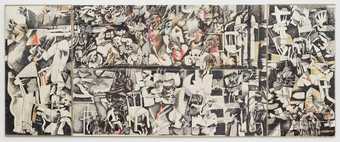I’m Dia Azzawi, artist originally from Iraq, living in London since 1976. My interest in art goes back to my childhood. After I studied archaeology, then I started to go and study more art, or in particular, paintings. From 1976 when I’m here, I take more interest in printing. What I’m trying, actually, to go back a little bit to my roots of culture as an Iraqi, at the same time it gives me the opportunity to look to my culture from abroad. In a way, it’s a new window. For example, when I was living in Iraq, I thought I have everything, in a sense. When I left and came to London, Iraq becomes like a small village. I managed to get more knowledge about my culture, about my history, when I’m here rather than when I was in Baghdad.
This is the painting which I’m working on in the last two months. This is some of the models which I did as an idea to enlarge it, and this kind of work. For example, I produced this one in marble and two metres. This is also another piece which I did, called Missing a friend. This is about...also from a friend who was killed years ago, and in that sense, which I tried just to keep that space empty, to mention that they no longer exist, compared to this one. And you can see here by the influence of my work as a painter using different colours in the sculptures.
The challenge, I think, to produce a large piece, it’s a great challenge than a small one. You can control when you have a small one, but when you have a large piece, then you have to think about it in terms of composition, in terms of the various elements which you can put together. I mean, for example, for any success painting, if you have it on the wall, should be, and the eyes go round, without, in a way, your eyes escaping to the other painting.
The painting which was acquired recently by the Tate has the title of The Sabra and Shatila Massacre. From the beginning I thought to produce a painting which suggests the tragedy of violence, the contrasts and interrelation between death and life. The tragedy in this particular massacre was that most of the people there were innocent men and women, children, estimated more than 3,000 people killed in one night. I tried to produce something which is not propaganda, in a sense. It is documenting a tragedy.
In a way, the whole world is very small...a small village. That means if I can give you some influence from my culture and you give me yours, this is what we are supposed to have, now. This is human creativity which can belong to anybody.

